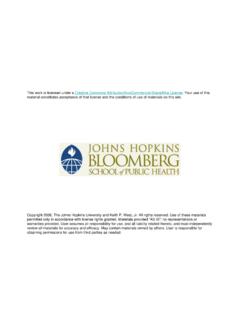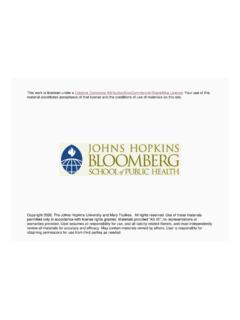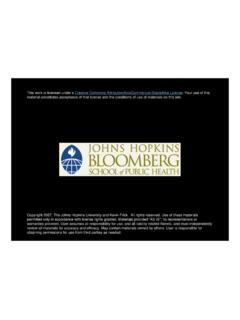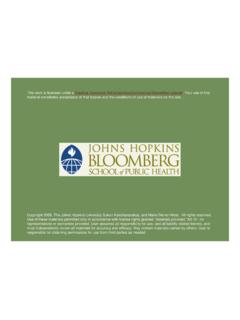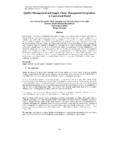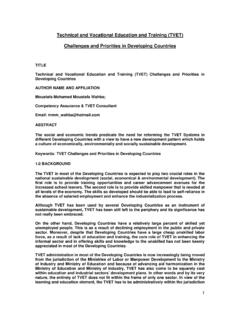Transcription of This work is licensed under a Creative Commons Attribution ...
1 This work is licensed under a Creative Commons Attribution -NonCommercial-ShareAlikeLice nse. Your use of this material constitutes acceptance of that license and the conditions of use of materials on this 2006, The Johns Hopkins University and David rights reserved. Use of these materials permitted only in accordance with license rights granted. Materials provided AS IS ; no representations or warranties provided. User assumes all responsibility for use, and all liability related thereto, and must independently review all materials for accuracy and efficacy. May contain materials owned by others. User is responsible for obtaining permissions for use from third parties as and DevelopmentTheories on InterrelationsModule 3a2 Learning Objectives Evaluate the existing evidence for economic, social and environmental consequences of population growth Identify and analyze other exogenous factors perpetuating /mitigating the effects of population Growth and Economic Development Main Question: Causation ?
2 Relationship: A complex interrelated system, many variables are associated with both birth rates and rates of economic growth Evidence: Sparse, inconsistent and inconclusive, suggesting that both arrows are working in the systemDevelopmentPopulation size & rate of growth4 Theories of Population and Development Interrelations The Pessimistic Theories (orthodox view)Thesis: Supply of some natural resources (non-renewable) and capital is fixed Supply would grow more slowly than the populationPopulationDevelopment5 Theories of Population and Development interrelationsMalthusian theory Population tends to increase at a geometric rate Food can only increase arithmetically Population expands to eat up any surplus Subsistence wages forever unless moral checks Choose moral checks or positive checks6 Theories of Population and Development interrelationsNeoMalthusian Theory (Coale-Hoover,1958) 1940s-1960s: An era of unprecedented growth of population in the developing world Coale and Hoover.
3 Alternative projections of GNP for India and Mexico under assumptions of constant fertility and declining fertility Social expenditure on school and health due to young age structure diverted funds from capital Theory Conclusion of the theory:High population growth causes poor socio-economic development Policy Implications:Government should intervene to control populationcontinued8 Coale-Hoover Theory: Limitations Assumed economic growth as a function of onlycapital growth Does not take into account the changes in technology and labor quality (through better heath and schooling of new generation) Empirical evidence: Relationship not consistently negative (Blanchet)9 Population growth and economic development interrelationshipThe Optimistic Theories Population growth exerts a positive influence on economic development Human ingenuity would create the technology to overcome any environmental constraints to development (Boserup, Julion Simon).
4 10 Marxism and Population A Surplus population is a creation of capitalism, and a necessary condition for its continuance Capitalism requires a surplus of readily exploitable manpower which it creates by expropriating land, and by displacing workers with machines11 Theories of Population and Development interrelationsRevisionist Theory-1 International Population Conference,1974: Development is the best contraceptive Theory: Underdevelopment produces rapid population growth. Policy Implications: Invest resources in development activities Set the world economic order rightDevelopmentPopulation12 Theories of Population and Development interrelationsRevisionist Theory-2 POPOULATION DEVELOPMENT International Population Conference, 1984, Mexico: USA position Theory: Population is a neutral phenomenon in the process of economic development Policy Implications: Other issues must take priority, economic reforms, free markets, democracy of Population and Development interrelationsCurrent Thinking(NAS,1986) The scientific evidence.
5 Still inconclusive, links more clear at individual/household level rather than at national/regional level Implication of rapid population growth vary considerably depending on economic, cultural, institutional and demographic differences among LDC. continued14 Theories of Population and Development interrelationsCurrent thinking (NAS,1986) Population growth in not necessarily the principle cause of problems in LDC, but it does multiplies the damage caused by other world problems (unequal population distribution). Just slowing population growth can not solve such problems,but can contribute to their of Population and Development interrelationsICPD,1994, Cairo Affirmation of Revisionist-2 with a new paradigm shift HUMAN RIGHTS POPULUATION DEVELOPMENT Theory: Human rights are at the center of concerns for sustainable development Policy implications:Advancing gender equality, equity, and empowerment of women are key to population and development related programs16 Summary Slide This concludes this session.
6 The key concepts introduced in this session include: Theories on inter-relationships between population growth and development Malthusian and Neo-Malthusian theories The consensus emerged from previous three International Conferences on Population17 Population and DevelopmentInterrelationsModule 3b18 Part II: Population growth and specific aspects of development Population and deforestation, and agriculture development Population and employment Population growth and education Population, food and nutrition Population and water resources Population and urbanization19 Population growth, Agricultural Stagnation and Environmental Degradation: The Nexus Multiple and synergistic links between rapid population growth,poor agricultural performance and environmental degradation Relationships are difficult to analyze, as multiple factors affect rate of population growth,environmental degradation, and pace and direction of agricultural developmentContinued20 Population growth, Agricultural stagnation and environmental degradation: The nexus Boseruphypothesis: Agriculture intensification occurs as population density on agricultural land increases.
7 Sub-Saharan Africa: Agriculture expansionrather than intensification. Continued21 Population Growth, Agricultural Stagnation and Environmental Degradation: The Nexus Expansive agriculture involved conversion of large areas of forest,wetlands, river valley bottoms, and grassland savanna to crop land. Agriculture expansion + rapid population growth = accelerated degradation of natural resources = agricultural Perpetuating the Nexus Deficiencies in economic policy environment ( agricultural pricing, excessive control of agricultural marketing, lack of empowerment of farmers): Slowed the evolution of ancestral systems into systems more sustainable with higher population density Lack of rapid and widespread technological change23 Traditional Tenure Systems And The Nexus Rapidly rising population pressure makes effective common ownership regulation increasingly more difficult Rapid population growth led to an erosion and breakdown in customary laws and rules governing sustainable use and management of land and other common property resources24 Deforestation ,Fuelwood, and The Nexus 90% of households in Sub-Saharan Africa use wood-fuel as the staple source of energy.
8 Slow economic growth will impede the switch to non-wood fuels. Hence the demand for wood-fuel would increase with population growthContinued25 Deforestation ,Fuelwood, and The Nexus In 1980s, eleven countries including Uganda,faced negative fuel-wood supply-demand balances. Has important negative effects on rural women, health, nutritional patterns and soil conservation26 Labor Force and Population Growth Labor force: population 15-65,who is actively seeking jobs Growth of the labor force in future will depend upon: Age structure of the population: younger the population-faster will be growth Current fertility levels Economic activity rates by age and sex27 Labor force growth and age structure28 Bigger and bigger cohorts will enter the labor force in next 15 years due to past high fertilityAny efforts to reduce fertility will have delayed effect on labor force sizeJobs and Population Growth May boost labor demand, but definitely boosts labor supply-35 million people will enter global labor force/year Interaction between population growth and unemployment more acute among nations with younger population-SSA has 45% population under 15 years Measures to reduce population growth have a delayed effect on labor force size29 World Labor Force.
9 1995,With Projection to 2050 YearRegion19952050 AdditionalJobsrequired1955-2050% Changein laborforce(1955-2050)(in millions)World2,7354,4551,72076 MDC598513-(84)-(17)Developing countries2,1273,9281,80685 Least developed countries258866607235 Source: United Nations,199930 World Labor Force Almost doubled since 1950s ( billion to billion) Currently One-third labor force is un/underemployed (ILO) Creation of billion jobs is required to maintain current levels of employment in next 50 years Almost all future growth will be in developing countries 31 Jobs and Population Growth: Aggravating Factors Increasing acceptance of women s labor force participation (may be offset by its effect on fertility?)
10 Declining global per capita grain-land (traditional source of employment): declined by 50% in certain nations since 1950s Slow pace of industrialization Effect of HIV/AIDS epidemic32 Jobs, Population Growth and SSA SSA-already facing double digit unemployment rate The size of labor force will more than triple by 2050 Will have to absorb twice as many new entrants as in year 1998, each year in next 20 years However, HIV/AIDS epidemic in SSA may change the projections33 Education and Population Growth: Global Situation Between 2000-2050, the total population will increase by 47%, but population less than 15 years will decline by 3% (UN) due to overall slowing population growth rate Need for education infrastructure will rise very slowly in next 25 years, decline thereafter34 Education and Population Growth.



